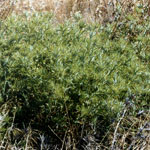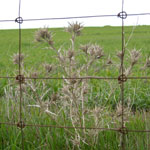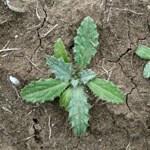Soldier thistle
Common name:
- Soldier thistle
Scientific name:
- Picnomon acarna (L.) Cass.
Plant status
Catchment management authority boundaries
Regionally prohibited in the North Central, Port Phillip and Western Port catchments.
Regionally controlled in the Goulburn Broken and North East catchments.
Restricted in the Mallee, Wimmera, Corangamite, Glenelg Hopkins, West Gippsland and East Gippsland catchments.
Plant biology
Appearance
Herbaceous plant — Forb (flowering herbaceous plant — not a grass)

Description
Soldier thistle is an erect annual herb growing to 1m high. Yellow-green in appearance due to numerous yellow spines on the leaves.
Stems
Stems of soldier thistle are ranched with spiny wings and dense white hairs. They are woolly in appearance.
Leaves
Soldier thistle leaves are covered with fine white hairs and yellow spines, 1 to 1.5cm long. White hairs on the leaves give them a woolly appearance.
Rosette leaves grow to 30cm long while stem leaves alternate and are long and narrow, about 1 to 1.5cm in length.

Flowers
Soldier thistle has pink or purple flower heads, growing 2 to 4cm long and can be solitary or in groups at the end of branches.
Flowers are formed in late spring from September to November with the plant flowering in early summer.
Seeds
The seeds of soldier thistle are smooth and shiny with a detachable parachute of bristles on one end about 4 to 6mm long.
Seed germinates mainly in autumn, but has been seen to germinate after sufficient summer rainfall in disturbed areas.

Growth and lifecycle
Method of reproduction and dispersal
Wind is the main method of dispersal for this weed. Seeds can disperse over short distances and whole plants can also be blown around after breaking off at the base. Seeds can also be carried on animals, vehicles, machinery and in water.
Rate of growth and spread
Soldier thistle grows rapidly in spring, particularly on heavy red-brown soil and spreads fast in degraded areas with little competition. It can compete with crops in favourable conditions.
Seedbank propagule persistence
A small percentage of solder thistle seeds can remain viable in the soil for several years. Plants may appear on recently cultivated areas where there has been no seeding for several years.
Preferred habitat
Soldier thistle prefers semi-arid to sub humid areas of temperate regions on dry sandy or stony soils. It is a weed of roadsides, channel banks, neglected areas and occasionally cereal crops and pastures in areas with an annual rainfall of 300 to 600mm.
Distribution
In Victoria, soldier thistle is found in the Mallee and northern regions of the state.
Growth calendar
The icons on the following table represent the times of year for flowering, seeding, germination, the dormancy period of soldier thistle and also the optimum time for treatment.
| Jan | Feb | Mar | Apr | May | Jun | Jul | Aug | Sep | Oct | Nov | Dec | |
|---|---|---|---|---|---|---|---|---|---|---|---|---|
| Flowering | ||||||||||||
| Germination | ||||||||||||
| Dormancy | ||||||||||||
| Treatment |
Impact
Agricultural and economic impacts
Well-established infestations of soldier thistle can compete with crops and choke harvesting equipment. The sharp spines of the plant can injure animals and are generally avoided by stock.
Management
Prescribed measures for the control of noxious weeds:
- application of a registered herbicide
- physical removal
Read about prescribed measures for the control of noxious weeds.
Other management techniques
Changes in land use practices and spread prevention may also support soldier thistle management after implementing the prescribed measures.